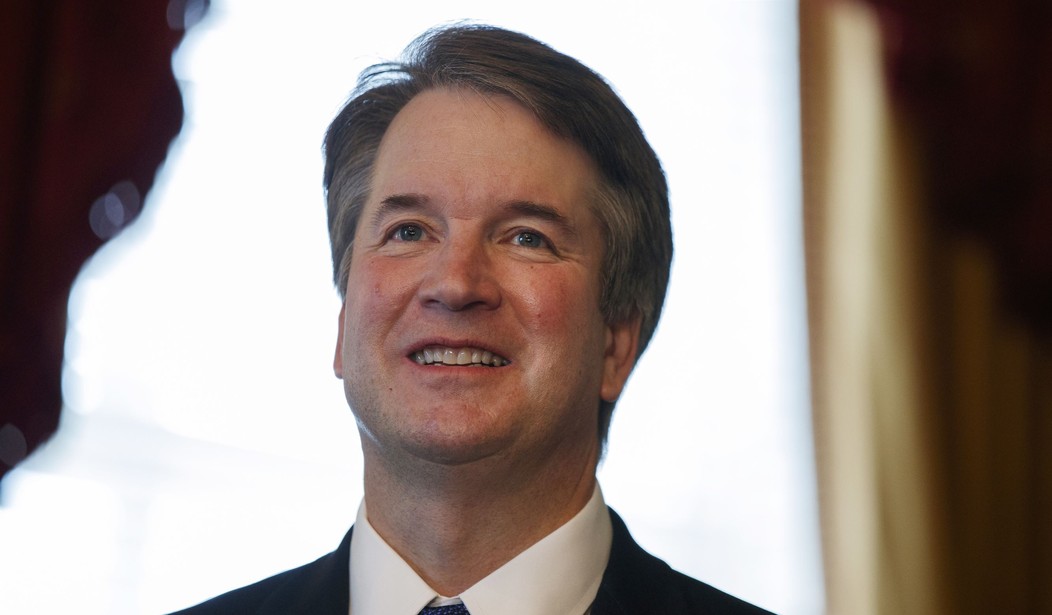When Trump singled out Judge Brett Kavanaugh as his pick for the Supreme Court on Monday, the president chose someone with a pretty straightforward and detailed record on gun control and the Second Amendment.
Back in 2011, Judge Kavanaugh was the dissenting vote on a three-member D.C. Circuit Court panel that voted 2-1 to uphold D.C.’s then-new gun control laws banning the possession of certain semi-automatic rifles and all magazines with a capacity of more than ten rounds and requiring that every legal gun be registered with the government. In a fifty-two page opinion explaining his dissent, Kavanaugh laid out his reasoning for why some of these gun control measures were unconstitutional, particularly in light of the Supreme Court’s previous 2008 Heller v. District of Columbia decision upholding individual Americans’ right to keep and bear arms [emphasis mine]:
In Heller, the Supreme Court held that handguns—the vast majority of which today are semi-automatic—are constitutionally protected because they have not traditionally been banned and are in common use by law-abiding citizens. There is no meaningful or persuasive constitutional distinction between semi-automatic handguns and semi-automatic rifles. Semi-automatic rifles, like semi-automatic handguns, have not traditionally been banned and are in common use by law-abiding citizens for self-defense in the home, hunting, and other lawful uses.Moreover, semi-automatic handguns are used in connection with violent crimes far more than semi-automatic rifles are. It follows from Heller's protection of semi-automatic handguns that semi-automatic rifles are also constitutionally protected and that D.C.'s ban on them is unconstitutional.
(…)
D.C.'s registration requirement, which is significantly more stringent than any other federal or state gun law in the United States, is likewise unconstitutional. Heller and later McDonald [v. Chicago, 2010] said that regulations on the sale, possession, or use of guns are permissible if they are within the class of traditional, "longstanding" gun regulations in the United States. Registration of all lawfully possessed guns—as distinct from licensing of gun owners or mandatory record-keeping by gun sellers—has not traditionally been required in the United States and even today remains highly unusual.
Recommended
With respect to D.C.’s ban on “large capacity” magazines, Kavanaugh was far more cautious in his opinion, noting that the parties in the case did not provide enough evidence to determine whether magazines that hold more than ten rounds are in “common use” or have traditionally been banned:
In order to apply Heller's test to this [magazine] prohibition, we must know whether magazines with more than 10 rounds have traditionally been banned and are not in common use. The parties here did not brief that question in much detail. Evidence presented to the District Court on the history and prevalence of magazines of more than 10 rounds would be helpful to the proper disposition of that issue under the Heller test. Therefore, I would remand to the District Court for analysis of that issue.
And yet, according to constitutional law professor David Kopel, who published a piece about “The History of Firearms Magazines and Magazine Prohibitions” for the Albany Law Review, guns that can hold more than ten rounds of ammunition have been around for hundreds of years, and commercially successful guns of this nature have been around practically since the founding of the United States:
Magazines of more than ten rounds are older than the United States. Box magazines date from 1862. In terms of large-scale commercial success, rifle magazines of more than ten rounds had become popular by the time the Fourteenth Amendment was being ratified. Handgun magazines of more than ten rounds would become popular in the 1930s.
(…)
At the time that the Second Amendment was being ratified, the state of the art for multi-shot guns was the Girandoni air rifle, with a twenty-two-shot magazine capacity. Meriwether Lewis carried a Girandoni on the Lewis and Clark expedition. At the time, air guns were ballistically equal to powder guns in terms of bullet size and velocity.
(…)
Firearm technology progressed rapidly in the 1800s… “Pepperbox” pistols began to be produced in America in the 1830s. These pistols had multiple barrels that would fire sequentially. While the most common configurations were five or six shots, some models had twelve independently-firing barrels, and there were even models with eighteen or twenty-four independently-firing barrels.
(…)
[T]he Volcanic Repeating Arms Company, introduced the lever action rifle in 1855. This rifle had up to a thirty-round tubular magazine under the barrel that was operated by manipulating a lever on the bottom of the stock.
(…)
The semiautomatic firearm and its detachable box magazine were invented before the turn of the century…
In 1896, Germany’s Mauser introduced the C96 “broomhandle” pistol, which remained in production until the late 1930s, selling nearly a million to civilians worldwide. The most common configuration was in ten-round capacity, but there were a variety of models with capacities as low as six or as high as twenty…
The Luger semiautomatic pistol was brought to the market in 1899 (although it is commonly known as the “1900”). Through many variants, it was very popular for both civilians and the military markets, and remained in production for nearly a century. The most common magazines were seven or eight rounds, but there was also a thirty-two-round drum magazine.
Of course, Americans continued throughout the 20thcentury and beyond to obtain and use millions of rifles and pistols with magazines that hold more than ten rounds, including the M1 carbine, the AR-15, and the Browning Hi-Power pistol, just to name a few obvious examples. That none of this relatively well-known information appeared to influence Kavanaugh’s opinion might reasonably concern Second Amendment supporters.
Hardcore gun rights advocates could also be concerned that Judge Kavanaugh argued in his dissenting opinion in favor of requiring gun owners to obtain licenses before purchasing firearms (especially given that some states have used stringent licensing requirements to make it very difficult for ordinary citizens to purchase guns):
Licensing requirements mandate that gun owners meet certain standards or pass certain tests before owning guns or using them in particular ways. Those laws can advance gun safety by ensuring that owners understand how to handle guns safely, particularly before guns are carried in public. For example, many jurisdictions that permit the carrying of concealed weapons have traditionally imposed licensing requirements on persons who wish to carry such weapons.
Still, on the whole, Kavanaugh’s opinion strongly suggests that if he makes it to the Supreme Court, he will be an important bulwark against gun control advocates’ efforts to ban entire classes of commonly-owned and traditional American firearms merely based on liberals’ stated intentions to keep Americans safe. On that basis, the NRA endorsed Kavanaugh’s nomination on Monday, calling the judge an “outstanding choice” with “an impressive record that demonstrates his strong support for the Second Amendment.”
In spite of his relatively nuanced views supporting gun control laws that fall in line with history and traditional legal precedent (such as gun licensing laws), Judge Kavanaugh has already been labeled as a “Second Amendment radical” by Sen. Chris Murphy (D-CT) and a “Christmas in July gift to the NRA” by the “Moms Demand Action” pro-gun control group, which is a part of former New York City mayor Mike Bloomberg’s pro-gun control “Everytown” group.
Brett Kavanaugh is a true Second Amendment radical. He believes assault weapon bans are unconstitutional, a position way out of the judicial mainstream, far to the right of even late Justice Scalia.
— Chris Murphy (@ChrisMurphyCT) July 10, 2018
President Trump's nomination of Judge Kavanaugh to the Supreme Court is a Christmas in July gift to the NRA. Kavanaugh has made clear he would strike down prohibitions on the AR-15 and other assault-style weapons. Urge your senators to OPPOSE this nominee: https://t.co/TyQc6vJN78 pic.twitter.com/AuPtOXX9WW
— Moms Demand Action (@MomsDemand) July 10, 2018
























Join the conversation as a VIP Member